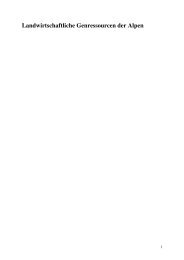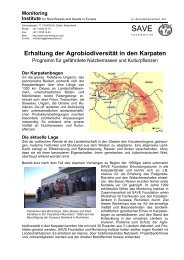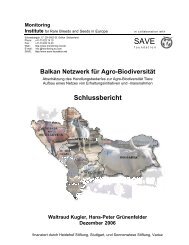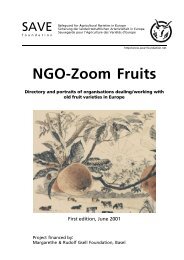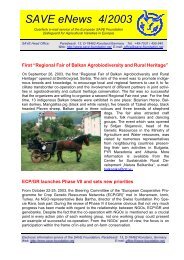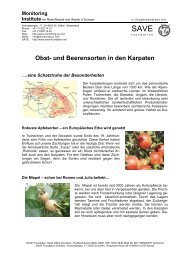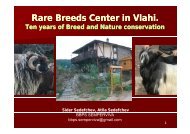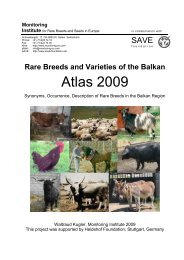The Busha cattle – a breed originated in middle ... - SAVE Foundation
The Busha cattle – a breed originated in middle ... - SAVE Foundation
The Busha cattle – a breed originated in middle ... - SAVE Foundation
You also want an ePaper? Increase the reach of your titles
YUMPU automatically turns print PDFs into web optimized ePapers that Google loves.
Kathar<strong>in</strong>a FAUKAL<br />
<strong>The</strong> <strong>Busha</strong> <strong>cattle</strong> <strong>–</strong> a <strong>breed</strong> <strong>orig<strong>in</strong>ated</strong> <strong>in</strong> <strong>middle</strong> ages<br />
made for the 21 st century?<br />
This paper is a work <strong>in</strong> progress.<br />
Keywords: <strong>Busha</strong>, <strong>cattle</strong>, Brachyceros, Kosovo<br />
1. Introduction<br />
Nowadays native <strong>cattle</strong> <strong>breed</strong>s are hardly found <strong>in</strong> modern <strong>in</strong>dustrial dairy and meat<br />
production. Commercial <strong>breed</strong><strong>in</strong>g focuses on high output of milk or rapid grow<strong>in</strong>g of<br />
the <strong>cattle</strong> to m<strong>in</strong>imize costs of hold<strong>in</strong>g animals and maximize efforts. Economically, it<br />
is useful to produce as much as possible with the smallest possible effort. But how<br />
reasonable/useful can this be for a region that cannot afford rais<strong>in</strong>g or feed<strong>in</strong>g these<br />
“turbo” <strong>cattle</strong>?<br />
<strong>The</strong> <strong>Busha</strong> <strong>cattle</strong> (Bos primigenius f. taurus) is a very orig<strong>in</strong>al <strong>cattle</strong> <strong>breed</strong> on the<br />
Balkan Pen<strong>in</strong>sula. Mostly located <strong>in</strong> the mounta<strong>in</strong>s, <strong>Busha</strong>s live on grass and bushes<br />
dur<strong>in</strong>g summertime. From autumn until spr<strong>in</strong>gtime they are kept <strong>in</strong> small stables, fed<br />
with small amounts of hay and sometimes corn or wheat. <strong>The</strong> <strong>Busha</strong>s provide the<br />
farmers and their families with sufficient milk and meat on a high quality level for the<br />
autonomic survival.<br />
<strong>The</strong> follow<strong>in</strong>g article will describe the advantages and disadvantages of pure <strong>Busha</strong>,<br />
synthetic <strong>Busha</strong>-commercial crosses and modern <strong>breed</strong>s at the example of the<br />
municipality of Suva Reka (Kosovo, Serbia). For this we needed to analyze data from<br />
local markets, prices of hay, corn, raw milk and life weight.<br />
2. Data reliability<br />
<strong>The</strong> Data has been surveyed <strong>in</strong> the course of many different visits to the farmers. A<br />
specific questionnaire was developed and translated <strong>in</strong>to Albanian (see addenda xx).<br />
Of course, the data is dependent on the truthfulness of the farmers´ accounts. Often,<br />
the farmers do not argue scientifically, but they embed their motives and the situation<br />
of their <strong>cattle</strong> <strong>in</strong>to their own family history and perspective, which is often shaded by<br />
history, tradition and the experience of war. Besides our own observations we have no<br />
other control mechanisms for the data. However, we especially observed the general<br />
performance data of those <strong>Busha</strong> <strong>cattle</strong>, their cross<strong>breed</strong>s, veter<strong>in</strong>ary service needed<br />
and personal statements of keep<strong>in</strong>g <strong>Busha</strong>s.<br />
Under the constra<strong>in</strong>s of primary survey, the data is reliable, <strong>in</strong> so far as the <strong>in</strong>terviews<br />
and structured questionnaires with the farmers are coherent.<br />
3. <strong>Busha</strong> <strong>in</strong> their environment<br />
3.1. <strong>The</strong> <strong>Busha</strong> <strong>cattle</strong><br />
<strong>The</strong> <strong>Busha</strong> (also Buša or Busa) belongs to an autochthon group of <strong>cattle</strong> throughout the<br />
Balkan Pen<strong>in</strong>sula, <strong>in</strong>clud<strong>in</strong>g Eastern Bulgaria and Greece. All of those <strong>breed</strong>s show<br />
small height, red to grey color, dark nose, short horns (“Brachyceros”) and are mostly<br />
1
Kathar<strong>in</strong>a FAUKAL<br />
located <strong>in</strong> the mounta<strong>in</strong>s. Relationship of <strong>Busha</strong> <strong>cattle</strong> to the follow<strong>in</strong>g <strong>breed</strong>s is<br />
probable:<br />
<strong>Busha</strong> <strong>cattle</strong> of former Yugoslavia<br />
Rhodope <strong>cattle</strong> of Eastern Bulgaria<br />
Illyrian dwarf <strong>cattle</strong> <strong>in</strong> Albania<br />
Prespa <strong>cattle</strong> <strong>in</strong> Albania<br />
Brachyceros <strong>cattle</strong> <strong>in</strong> Greece<br />
Uncerta<strong>in</strong>: Buša: Region of Lika, Croatia (Curic I., Dzidic A., 2004)<br />
Uncerta<strong>in</strong>: Indigenous <strong>breed</strong>s of Turkey (Turkish grey, Eastern anatolian red,<br />
Native black <strong>cattle</strong>, Southern yellow red)<br />
<strong>The</strong> performance of the kosovarian <strong>Busha</strong> <strong>cattle</strong> is well adapted to mounta<strong>in</strong> regions<br />
and hard liv<strong>in</strong>g conditions. Keep<strong>in</strong>g this as ground for this account, <strong>Busha</strong>s are longliv<strong>in</strong>g,<br />
used to small amounts on feed, resistant aga<strong>in</strong>st illnesses and parasites, have<br />
high fertility and are easy <strong>in</strong> calv<strong>in</strong>g. Cows produce up to 1000 kg milk per lactation,<br />
one calf each year is standard. Because of the surround<strong>in</strong>g conditions last<strong>in</strong>g for<br />
centuries, <strong>Busha</strong>s are small <strong>cattle</strong> (on average 114cm), with small f<strong>in</strong>ish<strong>in</strong>g weight (on<br />
average 260 kg) and late precocity (24 to 36 months). Because of their small weight,<br />
<strong>Busha</strong>s are optimal for pastur<strong>in</strong>g the sensitive grass landscape of mounta<strong>in</strong>s. Farmers<br />
notice more destroy<strong>in</strong>g by cross<strong>breed</strong>s and pure commercial <strong>cattle</strong> (Bytyqi H., 2006).<br />
Bulls stay with their herd and artificial <strong>in</strong>sem<strong>in</strong>ation is very seldom, because the sperm<br />
of <strong>Busha</strong> bulls is hardly to get. But even <strong>in</strong> those cows, which are artificially<br />
<strong>in</strong>sem<strong>in</strong>ated, pregnancy between 85% and 90% at first time is normal. Calves are born<br />
easily, mostly outside stables <strong>in</strong> mounta<strong>in</strong> regions without any help of humans. <strong>The</strong>ir<br />
liv<strong>in</strong>g weight at birth ranges between 15 kg and 25 kg, death at birth or dur<strong>in</strong>g<br />
upbr<strong>in</strong>g<strong>in</strong>g period is rare (Bytyqi H., 2006). Milk of <strong>Busha</strong> cows contents the same<br />
quantity of fat as commercial <strong>breed</strong>s and is well-tast<strong>in</strong>g. Until now, <strong>Busha</strong> milk has not<br />
been <strong>in</strong>vestigated on basic quality components, especially on fat, raw prote<strong>in</strong>, m<strong>in</strong>erals<br />
and vitam<strong>in</strong>s.<br />
3.2. <strong>Busha</strong> cross <strong>breed</strong>s<br />
After World War II, farmers started to cross<strong>breed</strong> <strong>Busha</strong>s with modern <strong>cattle</strong> like<br />
Fleckvieh, Tyrolean Grey, Brown Swiss, Red Danish and Holste<strong>in</strong> Frisian. This<br />
cross<strong>breed</strong><strong>in</strong>g was not coord<strong>in</strong>ated by governmental organizations or by the farmers<br />
themselves. Compar<strong>in</strong>g these cross<strong>breed</strong>s to pure <strong>Busha</strong>s, cross<strong>breed</strong>s are larger at<br />
birth, grow faster and their cows produce more milk. But veter<strong>in</strong>ary service is more<br />
often needed, papillomas, diarrhea etc. are more common than <strong>in</strong> <strong>Busha</strong>s. Compar<strong>in</strong>g<br />
to pure commercial <strong>breed</strong>s, the cross <strong>breed</strong>s are more resistant aga<strong>in</strong>st illnesses and<br />
parasites and need less amount of feed. So, <strong>Busha</strong>s <strong>in</strong>fluence cross <strong>breed</strong>s positively <strong>in</strong><br />
natural resistance, toughness, pregnancy rate and feed conversity, negatively <strong>in</strong><br />
performance.<br />
Summariz<strong>in</strong>g these observations, an overall view <strong>in</strong> Table 1 is given. In <strong>Busha</strong><br />
cross<strong>breed</strong>s performance depends on commercial <strong>breed</strong>, which is crossed <strong>in</strong>.<br />
2
Kathar<strong>in</strong>a FAUKAL<br />
Table 1: Comparison <strong>Busha</strong> <strong>–</strong> <strong>Busha</strong> cross <strong>–</strong> Commercial <strong>breed</strong><br />
BUSHA BREED BUSHA CROSSBREEDS<br />
Small; small body<br />
weight<br />
Max. 10 liters per day<br />
Low dependent on<br />
humans<br />
High fertility<br />
Easy calv<strong>in</strong>g<br />
Resistant aga<strong>in</strong>st<br />
illnesses and parasites<br />
Larger and heavier than<br />
<strong>Busha</strong> pure <strong>breed</strong><br />
Milk yield dependent on<br />
commercial <strong>breed</strong><br />
Dependent on humans<br />
Better fertility than<br />
commercial <strong>breed</strong>s<br />
Calv<strong>in</strong>g problems when<br />
crossed <strong>in</strong> <strong>breed</strong> is to large<br />
Higher resistance than<br />
commercial <strong>breed</strong>s<br />
4. Economic comparison<br />
4.1. Current situation <strong>in</strong> Municipality of Suva Reka<br />
3<br />
COMMERCIAL<br />
BREEDS<br />
Large; high body<br />
weight<br />
Max. 40 liters per day<br />
Dependent on<br />
humans<br />
Middle or bad<br />
fertility<br />
Problems <strong>in</strong> calv<strong>in</strong>g<br />
Low resistance<br />
aga<strong>in</strong>st illnesses and<br />
parasites<br />
In 2006 and 2007, farmers could hay only once a year. <strong>The</strong> absence of snow dur<strong>in</strong>g the<br />
w<strong>in</strong>ter period 2006/2007 and dry and hot weather <strong>in</strong> summertime prevented a second<br />
or third harvest. Prices upraised start<strong>in</strong>g with approximately 1.40 € per bale of hay (10<br />
to 15 kg) <strong>in</strong> April 2007 to 2.70 € - 3.50 € <strong>in</strong> September 2007. In percentage, a farmer<br />
has to pay approximately 250% more for one bale of hay. 40 kg corn rose from 6 € <strong>in</strong><br />
April up to 16 € <strong>in</strong> September (+170%). Dairies pay not more than 0.30 €/liter milk<br />
(0.27 € <strong>in</strong> April, +11%), on market sometimes farmers get 0.90 per liter. Many farmers<br />
began to sell their <strong>cattle</strong>, just keep<strong>in</strong>g a few cows to survive next w<strong>in</strong>ter, result<strong>in</strong>g that<br />
price for <strong>cattle</strong> did not get significantly higher s<strong>in</strong>ce April 2007 (1.65 €/kg up to 1.85<br />
€/kg life weight). Some farmers stopped hous<strong>in</strong>g <strong>cattle</strong> completely. This clean<strong>in</strong>g<br />
process allows only well situated or well economiz<strong>in</strong>g farmers to survive. And give<br />
those <strong>cattle</strong> chances which are low <strong>in</strong> costs and high <strong>in</strong> effort.<br />
4.2. Comparison <strong>in</strong> dairy production<br />
A 500 kg cow of Fleckvieh <strong>breed</strong> produc<strong>in</strong>g 25 liters milk a day at time of maximum<br />
lactation needs about 30 kg hay (cheapest possible quality taken for calculation) and<br />
10 kg corn a day to fulfill its performance. In April farmer would have to pay 4.30 €<br />
just for feed and get, if he sells the milk to dairies, 6.75 € for 25 liters (+ 2.45 €). In<br />
September, he would have to buy the same amount of feed for 9.40 € and only get 7.50<br />
€ for his product. A net loss of 1.90 € a day! Not <strong>in</strong>cluded costs for the veter<strong>in</strong>arian<br />
(artificial <strong>in</strong>sem<strong>in</strong>ation, treatments, correction of claws, etc.) or other overhead.<br />
Pure <strong>Busha</strong> <strong>breed</strong> is not able to produce 25 liters of milk per day. Farmers told us a<br />
maximum of 10 liters yield per day, but this amount is cont<strong>in</strong>uously produced by<br />
<strong>Busha</strong> cows until next calv<strong>in</strong>g, additional the mother cow has to feed its calf.<br />
Beg<strong>in</strong>n<strong>in</strong>g <strong>in</strong> spr<strong>in</strong>gtime last<strong>in</strong>g often until November <strong>Busha</strong>s live and pasture outside<br />
<strong>in</strong> the mounta<strong>in</strong> regions. <strong>The</strong>y leave their stables early <strong>in</strong> the morn<strong>in</strong>g, around 8.00
Kathar<strong>in</strong>a FAUKAL<br />
p.m. the herd returns. <strong>The</strong> whole graz<strong>in</strong>g period <strong>in</strong> the summer is done without extra<br />
hay or corn.<br />
Typical <strong>Busha</strong> farmers keep those <strong>cattle</strong> because of ma<strong>in</strong>ly three reasons: first of all<br />
they are easy hous<strong>in</strong>g animals, which do not need much feed, they are easy calv<strong>in</strong>g,<br />
every year a calf for sure and calv<strong>in</strong>g <strong>in</strong>terval is shorter; secondly, vets are only needed<br />
for ear mark<strong>in</strong>g, vacc<strong>in</strong>ation and deworm<strong>in</strong>g. <strong>Busha</strong>s even survive fractures (for<br />
example of their legs) because of their small body weight and very good heal<strong>in</strong>g<br />
conditions. And, thirdly, farmers keep <strong>Busha</strong>s because of tradition. Often, <strong>Busha</strong>s were<br />
present <strong>in</strong> families for more than one century.<br />
<strong>Busha</strong> farmers consume milk and dairy products with<strong>in</strong> their family. <strong>The</strong>se products<br />
are seldom sold to neighbors or <strong>in</strong> local markets. In the w<strong>in</strong>ter, <strong>Busha</strong> need 15 kg hay<br />
(cheapest possible quality taken for calculation) per cow per day, sometimes farmers<br />
feed them with 2 to 3 kg corn. <strong>The</strong>refore, farmers do not have any costs dur<strong>in</strong>g<br />
summertime, and <strong>in</strong> the w<strong>in</strong>ter, if <strong>Busha</strong>s live <strong>in</strong> their stables, with prices taken from<br />
September 2007, the farmer would need approximately 4.50 € per cow per day. If a<br />
farmer would sell 10 liters milk a day, he would ga<strong>in</strong> 3.00 € from diaries at the<br />
moment. If he buys milk from other farmers or super market, he would have to pay the<br />
usual price for 10 liters of raw milk of about 9.00 €.<br />
In total: A farmer with one Fleckvieh cow must pay for feed for one month 129 € <strong>in</strong><br />
April, 282 € <strong>in</strong> September (+119%). <strong>The</strong> Price for raw milk raised only 0.03 € or 11%<br />
per liter (total: 202.5 € <strong>in</strong> April up to 225 € <strong>in</strong> September for 25 liters milk): A total<br />
profit of 73.5 € <strong>in</strong> April, a total loss of 57 € <strong>in</strong> September. For one <strong>Busha</strong> cow, the<br />
feed<strong>in</strong>g costs also raised up by 108% (53.25 € <strong>in</strong> April, 111 € <strong>in</strong> September). <strong>The</strong><br />
profit <strong>in</strong> April would be 27.75 €, the loss <strong>in</strong> September 21 €.<br />
This small calculation, of course, is not quite correct. Firstly, <strong>Busha</strong>s are kept outside<br />
and do not need extra feed<strong>in</strong>g. Commercial <strong>cattle</strong> do need additional hay and corn,<br />
although they pasture every day. So farmers profit of animals, which do not need much<br />
additional feed<strong>in</strong>g. Second, the average output of milk of one Fleckvieh cow <strong>in</strong><br />
Kosovo is about 15 to 20 liters daily. <strong>The</strong> reasons for this phenomenon are many and<br />
various. Hay <strong>in</strong> Kosovo is not of the same good quality as <strong>in</strong> central European states.<br />
Farmers hay too late, therefore, the raw fiber quantity is too high, important<br />
components like raw prote<strong>in</strong>, m<strong>in</strong>erals and vitam<strong>in</strong>s are too low. To be able to milk<br />
more than e.g. 10 liters a day, farmers have to feed their <strong>cattle</strong> additionally with corn,<br />
rye, wheat and soya, furthermore with vitam<strong>in</strong>s and m<strong>in</strong>erals. Feed<strong>in</strong>g optimal<br />
balanced food five times per day is not a standard procedure <strong>in</strong> Kosovo. <strong>The</strong> reasons<br />
for this may be: ignorance, lack of knowledge or f<strong>in</strong>ancial problems. As a<br />
consequence, calves grow slowly, do not reach their maximum possible body weight,<br />
cows have problems with oestrus cycle and need often more than three <strong>in</strong>sem<strong>in</strong>ations<br />
to become pregnant. Maximum lactation cannot be noted at, for example, a mark of 30<br />
liters, but perhaps 20 liters or even less a day.<br />
4
Kathar<strong>in</strong>a FAUKAL<br />
4.3. Comparison <strong>in</strong> meat production<br />
Prices per kg body weight correlate with season. In w<strong>in</strong>tertime, the price is higher,<br />
dur<strong>in</strong>g the summer months, when most of engagements and wedd<strong>in</strong>gs take place <strong>in</strong><br />
Kosovo, the price is low. Traditionally, bulls are slaughtered for these family events.<br />
In April 2007, the price was noted about 1.65 € per kg body weight, slightly higher <strong>in</strong><br />
September 2007 (1.85 €/kg). Normally, bulls are fattened until an age of one year and<br />
sold <strong>in</strong> neighborhood or at local markets. Bulls of Fleckvieh weigh about 400 kg at this<br />
age, <strong>Busha</strong>-bulls approximately only 150 kg. <strong>Busha</strong>s cannot be compared to<br />
commercial <strong>breed</strong>s, because of their low daily <strong>in</strong>crease of body weight (maximum<br />
450 g) and longer upbr<strong>in</strong>g<strong>in</strong>g period, def<strong>in</strong>itively other <strong>breed</strong>s have advantages.<br />
<strong>Busha</strong>s’ disadvantage is m<strong>in</strong>imized <strong>in</strong> cross<strong>breed</strong>s. Cross<strong>in</strong>g <strong>Busha</strong>s and commercial<br />
<strong>breed</strong>s mix advantages of both types. <strong>Busha</strong>s br<strong>in</strong>g <strong>in</strong> their resistance and toughness,<br />
commercial <strong>breed</strong>s their rapid <strong>in</strong>creas<strong>in</strong>g body weight and higher slaughter weight <strong>in</strong><br />
less time. Quality of <strong>Busha</strong> meat is told to be much higher than of modern <strong>breed</strong>s.<br />
Hard conditions, a lot of herbs <strong>in</strong> feed, slow growth and daily sport <strong>in</strong> the mounta<strong>in</strong>s<br />
are possible explanations.<br />
5. Project<br />
A project to save, cultivate and develop this old <strong>breed</strong> would be desirable. Here, we try<br />
to expose some cornerstones of its design. With<strong>in</strong> this project, kosovarian and Austrian<br />
veter<strong>in</strong>arians at university level and local vets <strong>in</strong> Kosovo as well as the <strong>SAVE</strong><br />
foundation of Switzerland will cooperate. So far, we have def<strong>in</strong>ed 15 ma<strong>in</strong> targets:<br />
1. Collect<strong>in</strong>g data and preservation of<br />
a. Population <strong>in</strong> Kosovo<br />
b. Data of performance<br />
c. Gene pool<br />
2. Receive of<br />
a. traditional landscape of the area<br />
b. traditional agricultural structures<br />
c. natural hotspots <strong>–</strong> Cooperation with Organizations<br />
3. Set up database, herd book, strategy of <strong>breed</strong>, newsletter for <strong>breed</strong>ers<br />
4. Comparison with old <strong>middle</strong> European <strong>breed</strong>s (genetics)<br />
5. <strong>Foundation</strong> of <strong>breed</strong><strong>in</strong>g organization, basics for support of <strong>breed</strong>, bonus for<br />
hous<strong>in</strong>g, regular <strong>in</strong>come source for <strong>breed</strong>ers<br />
6. Network of <strong>breed</strong>ers, cooperation at private, university and public level<br />
7. Transnational network<br />
8. Network with European scientific <strong>in</strong>stitutes<br />
9. Set up a <strong>breed</strong><strong>in</strong>g station for sav<strong>in</strong>g the genetic pool, production of nitrogen<br />
frozen semen (cryobank), possibility for embryo transfer<br />
10. Promotion/Support of local specialties (dairy and meat products) made from<br />
<strong>Busha</strong>, support<strong>in</strong>g the private sector<br />
11. Education of consciousness to keep this <strong>breed</strong> alive <strong>in</strong> the local population<br />
5
Kathar<strong>in</strong>a FAUKAL<br />
12. Education and tra<strong>in</strong><strong>in</strong>g of local veter<strong>in</strong>ary students by Austrian veter<strong>in</strong>arians<br />
from Veter<strong>in</strong>ary University of Vienna<br />
13. Publications <strong>in</strong> <strong>in</strong>ternational Journals<br />
14. Set up and operat<strong>in</strong>g an Internet-Homepage for <strong>Busha</strong> <strong>cattle</strong><br />
15. Model for preservation other old <strong>breed</strong>s of Kosovo<br />
Of course, all these targets mean hard work for all partners, but the <strong>breed</strong> of <strong>Busha</strong><br />
<strong>cattle</strong> is worth keep<strong>in</strong>g alive. This article is published to make firsts steps <strong>in</strong>to this<br />
project and <strong>in</strong>troduce <strong>Busha</strong>s to the public.<br />
6. Conclusion<br />
Nowadays non-commercial <strong>breed</strong>s are highly endangered, because from a superficial<br />
po<strong>in</strong>t of view they are not able to match with modern, <strong>in</strong>dustrially stamped <strong>breed</strong>s.<br />
Uncontrolled cross<strong>in</strong>g of modern <strong>breed</strong>s nearly ext<strong>in</strong>cted <strong>Busha</strong>s. Both modern and old<br />
<strong>breed</strong>s are very important for develop<strong>in</strong>g new <strong>cattle</strong> <strong>breed</strong>s, which comb<strong>in</strong>e advantages<br />
and m<strong>in</strong>imize disadvantages. However, by cross<strong>in</strong>g them deliberatively farmers forgot<br />
their special aptitudes, e.g. their better shape for the environment.<br />
Breed<strong>in</strong>g better, faster, larger grow<strong>in</strong>g <strong>cattle</strong> also means loss of adaptation ability to<br />
environment, higher <strong>in</strong>cidence of illnesses, higher costs for owners and often pa<strong>in</strong>s for<br />
the animal itself. Heavy <strong>cattle</strong> destroy sensitive mounta<strong>in</strong> areas, need larger stables and<br />
special feed. Old <strong>breed</strong>s cannot claim modern performance, to get the same amount of<br />
milk three or four have to be housed <strong>in</strong>stead of one cow of commercial <strong>breed</strong><strong>in</strong>g. Slow<br />
growth and late precocity are further disadvantages of those old-fashioned <strong>cattle</strong>.<br />
Cross-<strong>breed</strong>s, although uncontrolled bred, between <strong>Busha</strong> and modern <strong>cattle</strong> grow<br />
larger and faster, amount of milk is larger and body weight is higher. <strong>The</strong>y are much<br />
more resistant than pure modern <strong>breed</strong>s, fertility rate is <strong>in</strong>creased, and complications <strong>in</strong><br />
giv<strong>in</strong>g birth are less. Life age of cross<strong>breed</strong> cows was noticed up to 25 years, still<br />
calv<strong>in</strong>g once a year.<br />
But without preservation of old <strong>Busha</strong> <strong>breed</strong>, fresh cross<strong>in</strong>g is not impossible.<br />
Especially it is important to keep <strong>Busha</strong> bulls, which are unfortunately very rare. One<br />
of the first steps of the project to save <strong>Busha</strong>s will be sav<strong>in</strong>g bulls and promote<br />
exchang<strong>in</strong>g them <strong>in</strong> between the local <strong>breed</strong><strong>in</strong>g groups.<br />
Watch<strong>in</strong>g development of prices throughout summer time, feed<strong>in</strong>g high performance<br />
<strong>cattle</strong> will be very difficult and not affordable for many farmers dur<strong>in</strong>g next w<strong>in</strong>ter.<br />
Even as soon as now <strong>in</strong> September we noticed many <strong>cattle</strong> with very low body weight,<br />
although most of them pastured on fields and grass land dur<strong>in</strong>g summer. Farmers<br />
own<strong>in</strong>g extensive <strong>cattle</strong> (<strong>Busha</strong>, <strong>Busha</strong> cross<strong>breed</strong>s) will profit def<strong>in</strong>itively and be able<br />
to survive w<strong>in</strong>ter months.<br />
6
Kathar<strong>in</strong>a FAUKAL<br />
7. Photographic documentation of <strong>Busha</strong><br />
Picture 1: Typical <strong>Busha</strong> <strong>in</strong> mounta<strong>in</strong> region <strong>in</strong> the southwest of Kosovo<br />
Picture 2: Typical <strong>Busha</strong> face (mounta<strong>in</strong> region <strong>in</strong> the southwest of Kosovo)<br />
7
Kathar<strong>in</strong>a FAUKAL<br />
Picture 3: <strong>Busha</strong> bull <strong>in</strong> mounta<strong>in</strong> region <strong>in</strong> the southwest of Kosovo<br />
Picture 4: <strong>Busha</strong> calf, male, approximately 3 months old (mounta<strong>in</strong> regions,<br />
southwest of Kosovo)<br />
8
Kathar<strong>in</strong>a FAUKAL<br />
Picture 5: <strong>Busha</strong> cross <strong>breed</strong> cow, approximately 25 years old, southwest of<br />
Kosovo<br />
Picture 6: Mounta<strong>in</strong> regions <strong>in</strong> southwest of Kosovo with mixed <strong>Busha</strong> and <strong>Busha</strong><br />
cross<strong>breed</strong> herd<br />
9
Kathar<strong>in</strong>a FAUKAL<br />
8. References<br />
Kugler W., Grünenfelder H.-P.( 2006):<br />
Balkan Netzwerk für Agro-Biodiversität Abschätzung des Handlungsbedarfes zur<br />
Agro-Biodiversität Tiere - Aufbau e<strong>in</strong>es Netzes von Erhaltungs<strong>in</strong>itiativen und <strong>–</strong><br />
maßnahmen Schlussbericht<br />
Monitor<strong>in</strong>g Institute for Rare Breeds and Seeds <strong>in</strong> Europe<br />
Schneebergstr. 17 CH-9000 St. Gallen Switzerland<br />
Bytyqi H. (2006):<br />
Animal genetic resources <strong>in</strong> the Kosovo<br />
University of Kosovo <strong>–</strong> Agriculture Faculty of Prisht<strong>in</strong>a<br />
Kume K., Papa L. (2006):<br />
Animal Genetic Resources - Rare Breeds <strong>–</strong> ALBANIA - State of the Monitor<strong>in</strong>g Efforts<br />
Pernik, Bulgarien<br />
Workshop Rare Breeds of the Balkan (2006):<br />
Rare Breeds of the Balkan - State of the Art - Contributions of workshop participants<br />
and other sources<br />
Workshop "Rare Breeds of the Balkan", Pernik, Bulgarien<br />
Workshop Rare Breeds of the Balkan (2006):<br />
<strong>SAVE</strong> Focus 2005 Special Edition Balkan - Transboundary occurr<strong>in</strong>g <strong>breed</strong>s and<br />
<strong>breed</strong> groups of the Balkan<br />
Workshop "Rare Breeds of the Balkan", Pernik, Bulgarien<br />
Stumberger B., Schneider Jacoby M., Sackl P. (2004):<br />
Domestic <strong>breed</strong>s of the Bojana-Buna Delta (Albania-Montenegro)<br />
Workshop "Rare Breeds of the Balkan", Dimitrovgrad, Serbia<br />
Erhart F. (2004):<br />
Nucleus Herd of Rhodope Cattle <strong>in</strong> East Bulgaria<br />
Workshop "Rare Breeds of the Balkan", Dimitrovgrad, Serbia<br />
Workshop Rare Breeds of the Balkan (2004):<br />
10
Kathar<strong>in</strong>a FAUKAL<br />
Native <strong>cattle</strong> <strong>breed</strong>s <strong>in</strong> Turkey<br />
Workshop "Rare Breeds of the Balkan", Dimitrovgrad, Serbia<br />
Markovic B. (2004):<br />
Review of autochthonous <strong>breed</strong>s and stra<strong>in</strong>s of farm animals <strong>in</strong> Montenegro<br />
Workshop "Rare Breeds of the Balkan", Dimitrovgrad, Serbia<br />
Biotechnical Institute <strong>in</strong> Podgorica, University of Montenegro<br />
Kume K., Papa L. (2004):<br />
In-situ conservation <strong>–</strong>the new action <strong>in</strong> the field of management of AnGR <strong>in</strong> Albania<br />
Dimitrovgrad, Serbia<br />
Curic I., Dzidic A. (2004):<br />
Animal genetic resources <strong>in</strong> Croatia: past actions, current state and prospective<br />
Dimitrovgrad, Serbia<br />
Workshop: <strong>cattle</strong> and buffaloes (2004):<br />
Situation of Brachyceros/<strong>Busha</strong><br />
Workshop "Rare Breeds of the Balkan"Dimitrovgrad, Serbia<br />
Department of Animal Breed<strong>in</strong>g and Genetics, School of Veter<strong>in</strong>ary Medic<strong>in</strong>e<br />
Hannover (2007):<br />
Breed description: Busa - CATTLE <strong>in</strong> YUGOSLAVIA<br />
http://w<strong>in</strong>.tiho-hannover.de/e<strong>in</strong>richt/zucht/eaap/descript/52.htm<br />
All pictures made by the author.<br />
11



